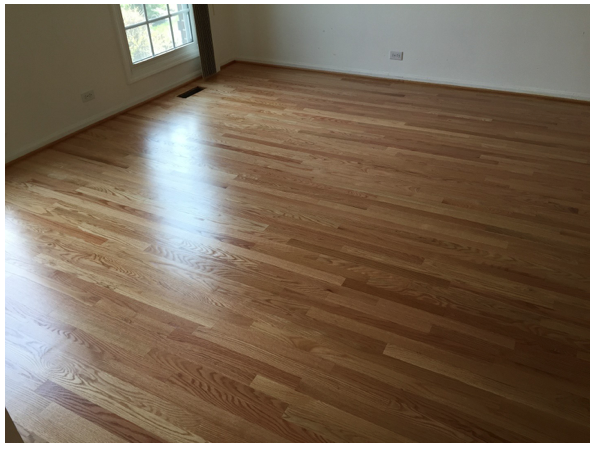How To Refinish Your Hardwood Floors: Finishing a Hardwood Floor with Oil Based or Water Based Finish
We conclude our series this week.We hope that you found the information as informative as usual. As always, we're here to help; we'll gladly take your questions.
Well, we’re almost done! All that’s left is the fun, and enjoyable part of the process: vacuuming and applying finish. After your final buffing pass be sure to properly vacuum the entire floor. Do not leave any dust or debris behind. Next, it is highly recommended, all though not mandatory, to get a bona mop or something similar, attach a dry microfiber cloth or rag to the bottom, and tack the entire floor to clean up and remove any remaining dust left behind from vacuuming. This will produce the cleanest and smoothest finish and is a great habit to get into.
Now, the question I always receive is, “What finish do I use Patrick!?” Well, unfortunately, that is not something I can just generically answer in this article. Every floor is different and each floor encounters different amounts of traffic and pets. The big question these days is do I use oil based finish on my floor or do I use water based finish? Water based finish, in my honest opinion is a much superior finish. However, it is MUCH more expensive than oil based finish (3 times more expensive, sometimes even 4 times more expensive PER GALLON). Water based floor finish is also much more difficult to apply. Why? Because of the drying time. Water based finish dries incredibly quickly and it is very difficult to continually stay working off of a wet edge, so the chance of lap marks and uneven spots if a novice is applying are very great. This is why for the first time user, even though I think water based finish is the superior product, I would recommend oil based finish. It dries slowly and gives you plenty of open time to smoothen and level everything out properly. Oil based finish is much cheaper and overall just much easier to work with for the first time user.
The next question is, "how do I apply it"? Well, let me tell you how not to apply it. Don’t listen to what Mr. Home Depot man tells you when he says you should buy the Minwax HD Brand polyurethane and apply it with a lamb’s wool applicator. I can 100% guarantee you that this will leave you unhappy, and in most cases actually force you to re-sand the floor. Applying with a lamb’s wool applicator is in some cases acceptable, however, it is VERY outdated and rarely ever used anymore. Although apart from the lamb’s wool applicator, the main problem lies in the finish itself. Home Depot is not a flooring company, they are a big name store simply providing people with the cheapest prices for some of the cheapest products available. In every case, the Minwax HD Brand Polyurethane is the absolute WORST choice you can make in picking a finish for your floor. This is the most important step after the sanding is completed. If you skimp out on the quality of the finish that you purchase, it will reflect poorly on your entire project and essentially turn out to be a huge waste of time.
Minwax products are not meant for hardwood floors, they are meant for cabinets and furniture. This is where I highly recommend you return to your hardwood flooring store supplier where you rented the professional grade equipment from and ask them for their recommendation on oil based polyurethane. There are many options: Duraseal, Masterline, and Poloplaz just to name a few. Any of those would be a great option.
Now the next step, how do I apply it? Well, in this case the industry itself is actually split right down the middle; many professionals apply finish with a T-bar, however, many also prefer to apply finish with a roller. I personally am a roller guy, so I will focus on that method. I have found that the perfect roller nap is 3/8 thick. That is what works for me and what has always worked for me in the past, though your preferences may be different. I’d recommend picking up the Purdy White Dove roller 3 pack that is usually on sale at the big box stores. This will be able to give you a fresh roller cover for the entire project, cleaning these is usually just a waste as it is very messy and overall just a better idea to have a clean roller cover for every coat to make sure previous debris doesn’t find its way into the next coat of finish.
You will also need a brush in order to cut in the edges of the room. The brush is 100% whatever your preference may be and any old brush should do just fine.
To begin, you must decide whether to work out of a bucket or pour straight onto the floor. For first time users I’d recommend working out of a bucket in order to not flood the floor with finish. Wet your brush in the bucket and cut in the edges of the room. Next, dip your roller into the bucket and begin rolling the entire length of the room. It is good practice to go with the grain of the wood, however, with rolling you can actually go against the grain as well and it will level out well if done properly. Be sure to work towards an exit in order to not paint yourself into a corner!
Once finished, throw away the roller cover and brush and let the floor dry overnight. When you return the next day the floor should be dry, however, you may be alarmed. The floor may not look spectacular or feel spectacular for that matter either. You might see lap lines and the floor could feel a bit sharp and have “texture” to it. Do not be alarmed. This is COMPLETELY NORMAL. You must now take a 150 grit, 180 grit, or 220 grit buffing paper and hand sand the entire floor lightly in order to not go through the finish, doing this should smoothen the floor and give off a white powdery dust. To speed up the process you can buff the floor or random orbit the floor, though doing this you run a greater risk of sanding through the coat of finish so I’d recommend just a quick hand sanding. It shouldn’t take very long. Next, vacuum the floor, tack the floor with a dry cloth again, and apply the final coat with the same technique as the first coat. Let the floor dry overnight and in the morning you should return to something as beautiful as this!
I wish you the best of luck with your next project!
- Patrick Dymora


